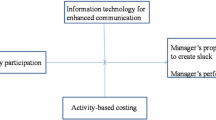Abstract
Economic value added, which is the currently popular term for the traditional accounting concept of residual income (RI), subtracts from operating income an interest charge for invested capital. This paper provides an activity-based cost system that supports RI maximization. We construct a model of participative budgeting for a multi-activity firm in which the cost system allocates plant and equipment cost to products using a formula that includes the interest charge. The budget system we design enables decision makers to identify RI-improving opportunities for outsourcing and dropping unprofitable products. The budget system also has the “open-architecture” property that additional informal communication among activity managers can only serve to increase RI.
Similar content being viewed by others
References
Anctil, R. (1996). “Capital Budgeting Using Residual Income Maximization.” Review of Accounting Studies1(1), 9–34.
Anctil, R., J. S. Jordan, and A. Mukherji. (1997). “The Asymptotic Optimality of Residual Income Maximization.” Review of Accounting Studies, 2(3): 207–229.
Banker, R. D., and J. S. Hughes. (1994). “Product Costing and Pricing.” Accounting Review69(3), 479–494.
Christensen, J., and J. Demski. (1995). “The Classical Foundations of 'Modem' Costing.” Management Accounting Research (U.K.)6(1), 13–32.
Cooper, R. (1990). “Cost Classification in Unit-Based and Activity-Based Manufacturing Cost Systems.” Journal of Cost Management for the Manufacturing Industry Fall, 4–13.
Cooper, R. (1992). “Activity-Based Costing for Improved Product Costing.” In B. Brinker (ed.), Handbook of Cost Management, 1993 ed., Warren Gorham Lamont.
Cooper, R., and R. Kaplan. (1992). “Activity-Based Systems: Measuring the Cost of Resource Usage.” Accounting Horizons 6(3), 1–13.
Homgren, C., G. Foster, and S. Datar. (1994). Cost Accounting: A Managerial Emphasis. Eighth ed., Engelwood Cliffs, NJ: Prentice Hall.
Jordan, J. S. (1994). “Management Accounting in Activity Networks.” Mimeo.
Jordan, J. S., and D. Xu. (1994). “The Informational Requirements of Expected Profit Maximization.” Journal of Economic Theory, forthcoming.
Kaplan, R. (1994). “Flexible Budgeting in an Activity-Based Costing Framework.” Accounting Horizons 8(2), 104–109.
Mak, Y. T., and M. L. Roush. “Flexible Budgeting and Variance Analysis in an Activity-Based Costing Environment.'' Accounting Horizons8(2), 93–103.
Malcom, R. E. (1991). “Overhead Control Implications of Activity Costing.” Accounting Horizons 5(4), 69–78.
Noreen, E. (1991). “Conditions under which Activity-Based Cost Systems Provide Relevant Costs.” Journal of Management Accounting Research, 3 Fall, 159–168.
Stewart, G. B. (1991). The Questfor Value, New York: Harper Business.
Varian, H. (1992). Microeconomic Analysis, NY: Norton.
Author information
Authors and Affiliations
Rights and permissions
About this article
Cite this article
Anctil, R.M., Jordan, J.S. & Mukherji, A. Activity-Based Costing for Economic Value Added®. Review of Accounting Studies 2, 231–264 (1998). https://doi.org/10.1023/A:1018317230647
Issue Date:
DOI: https://doi.org/10.1023/A:1018317230647




